Harry Houdini made a career from escaping death. He wowed his crowds with his ability to perform death-defying tricks and always come out on top. It is almost comical that Harry Houdini’s death resulted from a ruptured appendix when he had escaped death so many times before. Even today, many people question the real cause of Houdini’s death, with some even going as far to say that it was a Spiritualistic plot.
A magical career
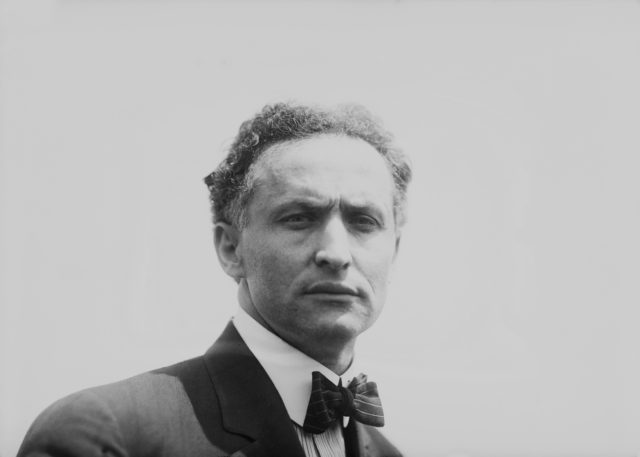
Harry Houdini was born on March 24, 1874, in Budapest, Hungary. Born Erik Weisz, he was one of seven children. When Weisz was four, he moved with his family to Appleton, Wisconsin, where he later claimed he was born. Here, the family changed the spelling of Erik’s name to Ehrich. When Ehrich Weisz turned 13, he went to New York City with his father. It was here that Weisz first became interested in the trapeze, calling himself “Ehrich, the Prince of the Air.”
In 1894, Weisz launched his career as a magician, changing his name to “Harry Houdini.” “Harry” was adopted from his childhood nickname, “Ehrie.” “Houdini” came from the great French magician Jean-Eugène Robert-Houdin, although Houdini would later conduct a study on exposing Houdin’s techniques and publish his findings in the book The Unmasking of Robert-Houdin (1908).
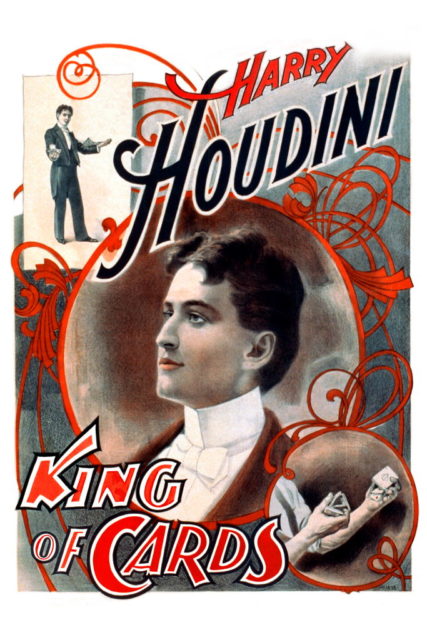
Houdini’s magic career was slow to take off. He initially played around with card tricks and performed at sideshows and circuses. He began finding real fame when experimenting with escape acts, specifically focusing on escaping handcuffs. In 1894, Houdini married Wilhelmina Beatrice Rahner, who became his lifelong stage assistant.
In 1899, Houdini’s handcuffs tricks caught the attention of entertainer manager Martin Beck. Beck soon had Houdini booked at some of the most prestigious vaudeville venues in America, followed by a European tour. Houdini’s shows were a huge success in both America and Europe. He was soon the highest-paid performer in American vaudeville and became widely known as “The Handcuff King.”
Notable tricks and performances
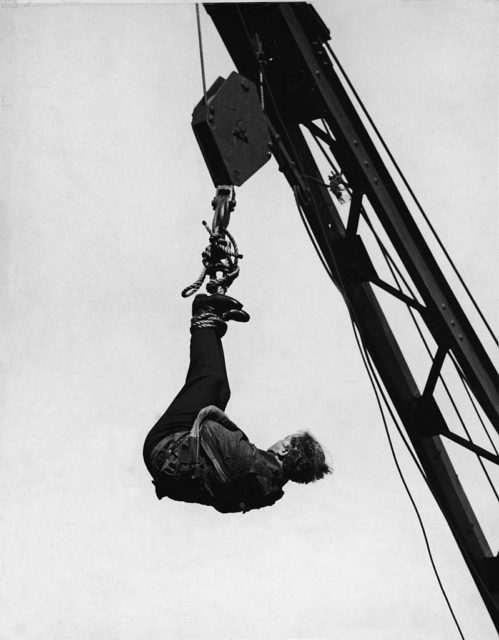
Houdini was known for constantly upping his antics, making each trick more difficult. In 1904, Houdini would perform the “most difficult escape of his career” when he escaped from a custom pair of handcuffs made by locksmith Nathaniel Hart. The Daily Mirror challenged Houdini to escape from these handcuffs, which could eventually do – but only after a lengthy struggle.
In 1908, Houdini introduced his own act, known as the “Milk Can Escape.” Houdini was handcuffed in a large milk can filled with water. This trick was advertised with posters promoting that “failure means a drowning death.” The trick was a massive success when it was first introduced, and Houdini began performing the escape as a regular part of his act. The audience was involved in this trick, as they were encouraged to hold their breath while Houdini escaped.
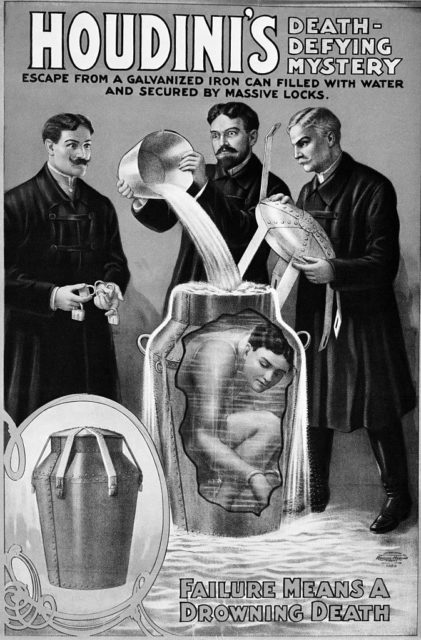
By far, Harry Houdini’s most famous trick involved his invention known as the “Chinese Water Torture Cell.” For this trick, Houdini’s feet were locked, and he hung upside-down above a tank filled with water. He was then lowered into the tank, and the lid was attached from the outside with six padlocks. He was allowed two minutes to escape – which he was able to do, much to the audience’s astonishment. During his lifetime, no one could figure out how Houdini escaped.
A knock-out trip to Montreal
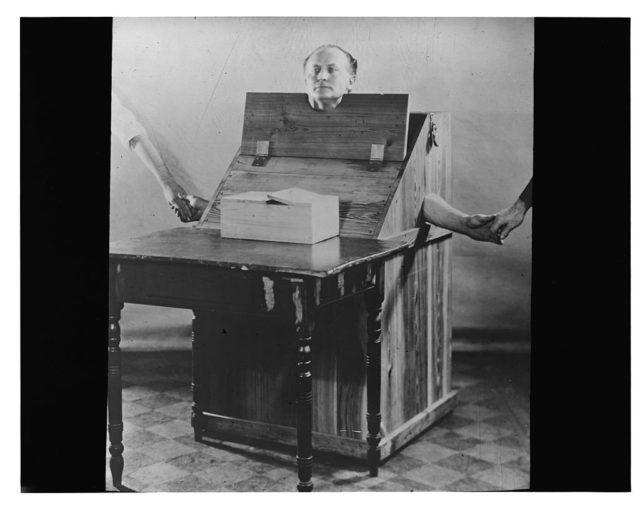
By 1926, Harry Houdini was at the top of his game. He had risen to international super-stardom and baffled audiences with his daredevil tricks. However, all this changed in the Autumn of 1926. During this tour, all tricks seemed to go wrong for Houdini. During a show on October 11 in Albany, New York, Houdini broke his ankle while performing his Water Torture trick. However, he managed to continue to muddle through his next performances against his doctor’s advice.
On October 19, 1926, Houdini gave a lecture at McGill University in Montreal, Canada. A few days later, on October 22, he invited some students to visit him in his dressing room at the Princess Theater. Three McGill students, named Samuel J. Smilovitch, Jack Price, and Jocelyn Gordon Whitehead, joined Houdini in his dressing room.
During the visit, Houdini was lounging, taking the weight off of his injured ankle. Somehow the conversation turned to Houdini’s physical strength as Whitehead asked if punches to the stomach truly did not hurt him. Whitehead then asked Houdini if he could test this claim by punching him in the stomach.
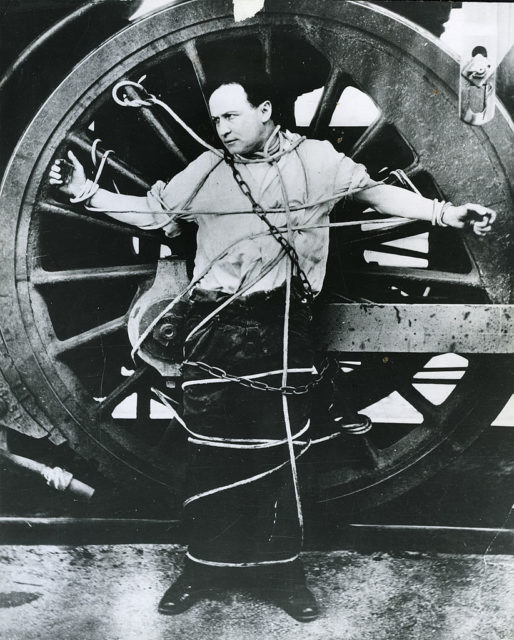
According to Jake Price, the scene unfolded as such: “Houdini was reclining at the time with his right side nearest Whitehead, and the said student was more or less bending over him. These blows fell on that part of the stomach to the right of the navel, and were struck on the side nearest us which was in fact Houdini’s right side; I do not remember exactly how many blows were struck I am certain, however, of at least four very hard and severe body blows, because at the end of the second or third blow I verbally protested against this sudden onslaught on the part of this
first year student, using the words, ‘Hey there. You must be crazy. What are you doing?’ Or words to that effect, but Whitehead continued striking Houdini with all his strength.”
Eventually, Houdini, who looked to be in extreme pain, asked Whitehead to stop punching him. Houdini defended himself by stating he had had no opportunity to protect himself, and that he didn’t think Whitehead was going to punch him as quickly as he did and with such force. He claimed he would have stood up from the couch if he had known Whitehead was about to throw a punch, but his ankle injury prevented him from moving quickly.
Despite his apparent pain, Houdini carried on with the show scheduled for that evening as well as two more performances given the next day.
Death by a ruptured appendix?
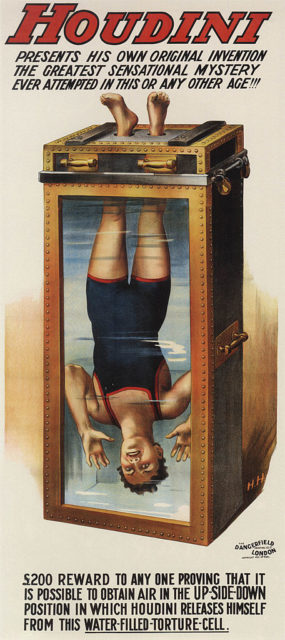
It was clear that Houdini was not feeling his best and only getting sicker during his remaining shows in Montreal. When Houdini boarded an overnight train headed for Detroit, where he was set to perform a new run of shows, he found could not sleep and was in constant pain. A doctor was telegraphed ahead of his first Detroit show to examine him.
After being examined by the doctor, Houdini was diagnosed with appendicitis. By now, Houdini’s temperature had risen to 104 degrees, he had developed cold sweats and was dealing with severe abdominal pain. The physician advised him to seek treatment at a hospital, but Houdini insisted on performing his opening show because the Garrick Theater had already sold $15,000 worth of tickets. Houdini apparently told the theater owner, “I’ll do this show if it’s my last.” Sadly, this prophecy came to pass.
Houdini attempted to make it through his show, but it was apparent he was not performing well. Audience members later reported that the magician missed cues and seemed to be in a hurry. By the middle of his third act, Houdini realized he could not go on. He asked his assistants to lower the curtains and immediately collapsed.
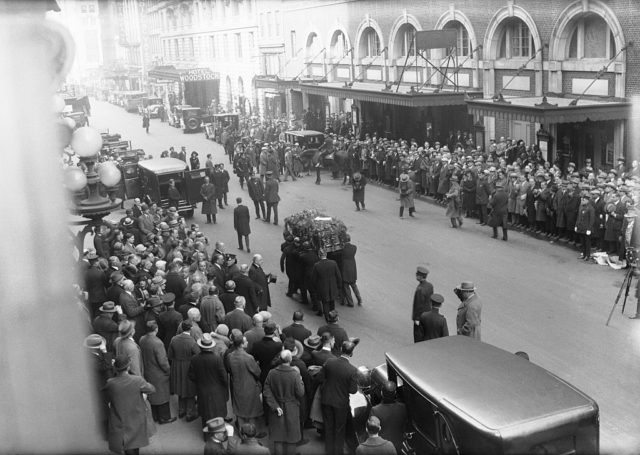
After the show, Houdini was taken to Grace Hospital in Detroit. Doctors successfully removed Houdini’s appendix, and discovered that it had burst several days earlier, coinciding with the time he was punched in the stomach. His organs were already poisoned because his ruptured appendix was removed days after it exploded.
Despite this prognosis, some believed that Houdini would make a full recovery. The magician clung to life until October 31, 1926, when he died with his wife and two brothers at his side. His last words allegedly were, “I’m getting tired of fighting… I do not want to fight anymore.” Houdini’s official cause of death was listed as diffuse peritonitis, meaning an infection of the tissue lining the abdomen’s inner wall, typically resulting from an abdominal rupture.
Was Houdini’s death the result of a Spiritualist plot?
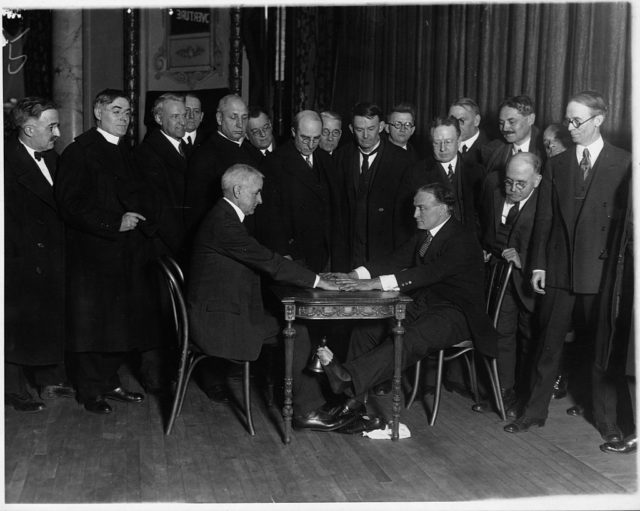
People were skeptical about Houdini’s death as more information began to emerge. Throughout his career, Houdini never claimed to be “magic,” rather, he referred to himself and his tricks as “illusions.” He was an expert masquerader but never marketed himself as magical. In this vein, Houdini resented the Spiritualist movement that was popular during his life and actively tried to debunk those who claimed they could communicate with the dead.
The Spiritualism movement was extremely popular during the 1920s, partly because of the mass amounts of death resulting from the First World War and the Spanish flu pandemic. The idea that someone could communicate beyond the grave gave many mourning people great comfort. “Mediums” became celebrities and were able to make fortunes “communicating” with the dead. Like Houdini, these mediums invoked numerous illusions and tricks to make their audience believe they were talking with the departed.
Houdini thought mediums and spiritualists were taking advantage of the grieving. In fact, only a few months before his death, he testified before Congress in support of legislation that would criminalize “any person pretending to… unite the separated” in the District of Columbia. He also worked to expose mediums and spiritualists across America.
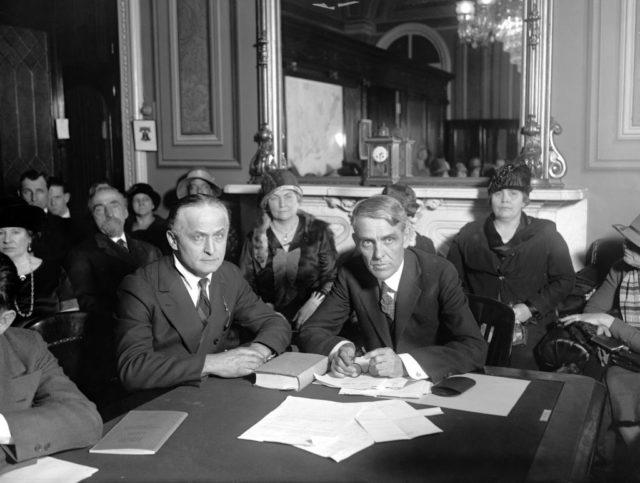
This crusade didn’t sit well with those individuals who believed in or were involved in the Spiritualist movement. Many people believe Houdini’s death was actually a carefully planned assassination. The 2006 book The Secret Life of Houdini argues that the Spiritualist community planned Houdini’s death and that the Spiritualists had a long history of poisoning their enemies. William Kalush and Larry Sloman conclude their book by writing, “if someone was hell-bent on poisoning Houdini, it wouldn’t have been very difficult.”
Some believe that Whitehead himself was somehow connected to the Spiritualist movement. Ultimately, there is no evidence to back up the idea of a Spiritualist plot to murder Houdini, and most scholars dismiss the idea that Houdini was murdered by the Spiritualists.
Houdini refuses to speak
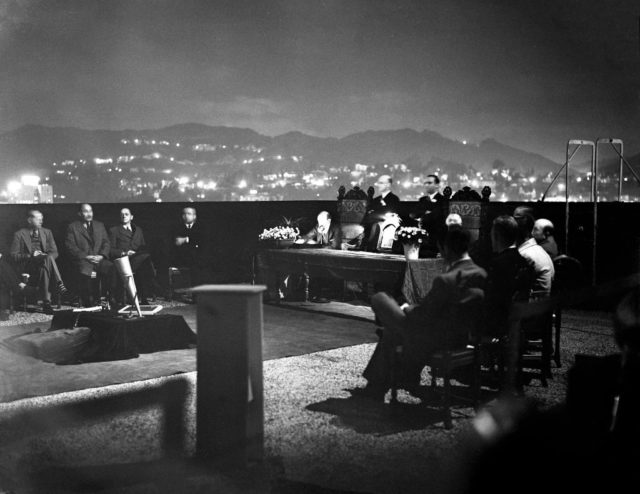
Despite intently working to discredit the Spiritualists, Houdini’s death became a heyday for the Spiritualist movement. Houdini and his wife Bess had made a pact: whichever one of them died first would attempt to communicate with the other from the grave. This would prove once and for all whether Spiritualism was real or not.
For the next nine Halloweens after Houdini’s death, Bess would hold séances in an attempt to communicate with her husband’s spirit. A decade after Houdini’s death, on October 31, 1936, Bess held her final séance in Hollywood Hills.
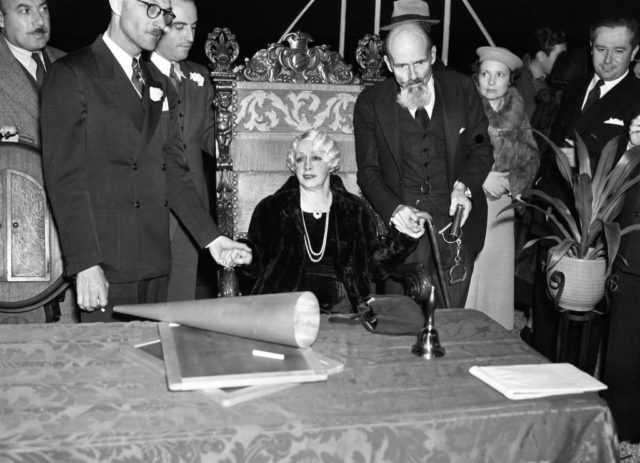
More from us: Houdini Abandoned His Escape Act To Teach Survival Skills During WWI
The final séance was held on a mountaintop to be “as near to the heavens as possible.” For over an hour, a medium begged Houdini to give them a sign that he was with him, but Houdini never “appeared.” At the end of the séance, Bess told the audience, “Houdini did not come through. My last hope is gone. I do not believe that Houdini can come back to me, or to anyone. After faithfully following through the Houdini ten year compact, after using every type of medium and seance, it is now my personal and positive belief that spirit communication in any form is impossible. I do not believe that ghosts or spirits exist. The Houdini shrine has burned for ten years. I now reverently turn out the light. It is finished. Good night, Harry.”
Even today, people attempt to contact Houdini on Halloween each year. However, he hasn’t been heard from during all these years.
